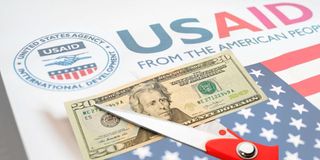Scientists warn of major rise in deaths as USAID folds

USAID was funding Kenya's health programmes.
What you need to know:
- Between the years 2001 to 2021, the aid that countries globally received from USAID helped in reducing HIV/Aids by 65 per cent followed by halving malaria and neglected tropical diseases cases.
- In Kenya, about 130, 000 people died of HIV/Aids in 2001.
Kenya and 132 other countries that were directly benefiting from the US Agency for International Development (USAID) risk losing about 14 million lives cumulatively by 2030 as an impact from the official folding of the aid agency.
A new study published in the scientific journal Lancet shares insights on this prediction, highlighting that any gains which had been made in the last two decades that ensured adult and child deaths had dropped will likely be reversed.
“Our estimates show that unless the abrupt funding cuts announced and implemented in the first half of 2025 are reversed, a staggering number of avoidable deaths could occur by 2030,” the scientists say.
Unlike previous studies that focused only on the direct impacts of health, this new study has broadened the scope to other indirect effects that can also lead to loss of lives and livelihoods, suggesting that those also have a ripple effect on people’s health outcomes.
The non-health programmes include cash transfers, poverty alleviation, education and water and sanitation interventions.
“Our estimates tend to be higher because they capture not only the direct effects of health-specific USAID interventions as considered in earlier studies, but also the broader effect of USAID-supported programmes on the social determinants of health. These effects could have substantially contributed to the agency's overall influence on mortality reduction,” they explain.
Their study shows that between 2000 and 2023, the number of global under-five deaths decreased from 10.1 million to 4.8 million.
“Our projections indicate that disruptions to such aid could jeopardise this progress, making it increasingly difficult—if not impossible—for the poorest and most vulnerable countries to achieve the Sustainable Development Goal target, reducing the under-five mortality rate to 25 or fewer deaths per 1000 live births by 2030,” the scientists worry.
The announcement
The research, which was funded by the Spanish Ministry of Science and Innovation, UK Medical Research Council, and EU Horizon Europe was published just a day before US Secretary of State Marco Rubio announced the official shutdown of USAID.
His 900-word speech titled ‘Make Foreign Aid Great Again’ marked a permanent dissolution of the agency.
“This era of government-sanctioned inefficiency has officially come to an end. Americans should not pay taxes to fund failed governments in faraway lands. Moving forward, our assistance will be targeted and time limited,” he said.
“The charity-based model failed because the leadership of these developing nations developed an addiction. State Department research finds the overwhelming sentiment in countries formerly receiving USAID funding is for trade, not aid,” he added.
In their argument, the scientists say that the funding was critical in improving global health and lowering deaths caused by poverty-related diseases.
“For many lower middle income countries, the resulting shock would be similar in scale to a global pandemic or a major armed conflict. Unlike those events, however, this crisis would stem from a conscious and avoidable policy choice—one whose burden would fall disproportionately on children and younger populations, and whose consequences could reverberate for decades,” they warned.
The scientists analysed all sectors that were previously funded by USAID as well as areas of intervention. Their associations were based on the 10 revision of the International Classification of Diseases with a focus on HIV/AIDS, tuberculosis, maternal deaths, lower respiratory infections, malnutrition, diarrhoeal diseases, malaria and neglected tropical diseases.
“High levels of funding were associated with lower mortality, in particular a 15 per cent reduction for overall age standardised mortality rate, 44 per cent for toddler deaths, and 32 per cent for under-five mortality,” the study shows.
“An estimated 91, 839, 663 all-age and all-cause deaths, including 30, 391, 980 all-cause deaths in children younger than five years were averted by USAID funding over the study period.”
Between the years 2001 to 2021, the aid that countries globally received from USAID helped in reducing HIV/Aids by 65 per cent followed by halving malaria and neglected tropical diseases cases.
In Kenya, about 130, 000 people died of HIV/Aids in 2001. The latest data released in 2023 shows that about 20,000 people lost their lives as result of the same disease.
“A modelling study for HIV/Aids estimated that HIV-related international aid reductions plus discontinued PEPFAR support could cause 4.43 to 10.75 million new HIV infections and 0•77–2•93 million HIV-related deaths between 2025 and 2030,” explains the study.
As part of their limitations, the researchers warn that the findings should be interpreted as providing strong support for a causal relationship, and that they do not constitute definitive evidence.


